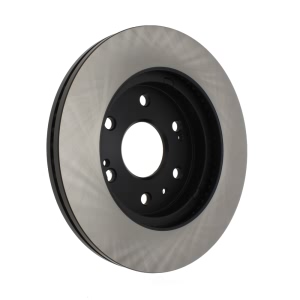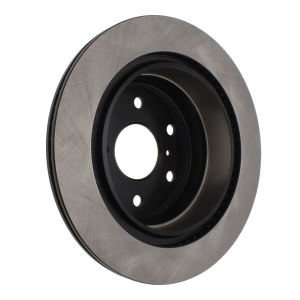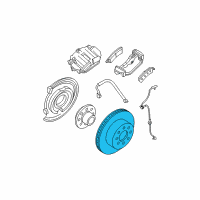< Back ×
2008 Cadillac Escalade ESV Brake Disc
My Vehicle Change Vehicle
2008 Cadillac Escalade ESV
< Back to View All
Brake Pads, Discs & Calipers
- Department
- Brands
- Prices

 $58.64Product Specifications
$58.64Product Specifications- Notes: Front Bracket Cast# 351C/352C
- UPC: 805890324904
- Part Description: 2008 Cadillac Escalade ESV Premium Vented Front Brake Rotor
Vehicle Fitment- 2008 Cadillac Escalade ESV | All Trims | All Engines

 $81.47Product Specifications
$81.47Product Specifications- Notes: with 330mm Diameter Rotor;6 Stud Wheel;with Black E-Coat on non-braking surface to prevent rust and corrosion
- Bolt Circle: 139.7mm (5.5")
- Lug Holes Quantity: 6
- Minimum Thickness: 28mm (1.102")
- Nominal Thickness: 29.97mm (1.18")
- Quantity: 1 Per Pack
- Rotor Construction: 1-Piece
- Rotor Design: Rotors Only
- Rotor Diameter: 329.82mm (12.99")
- Rotor Finish: With E-Shield™ Coating
- Rotor Height: 55.626mm (2.19")
- Rotor Material: Cast Iron
- Rotor Style: Plain
- UPC: 008536711070
- Part Description: 2008 Cadillac Escalade ESV Vented Front Brake Rotor
Vehicle Fitment- 2008 Cadillac Escalade ESV | All Trims | All Engines


Power Stop® PowerStop Evolution Performance Drilled, Slotted& Plated Brake Rotor Pair for 2008 Cadillac Escalade ESV
PartNumber: AR8654XPR$255.51Product Specifications- Bolt Circle: 140mm (5.5")
- Driving Style: Performance / Racing
- Hub Hole Diameter: 79mm (3.11")
- Lug Holes Quantity: 6
- Lug Holes Size: 16mm (0.63")
- Minimum Thickness: 28mm (1.1")
- Nominal Thickness: 29.97mm (1.18")
- Quantity: 2 Per Pack
- Rotor Construction: 1-Piece
- Rotor Design: Rotors Only
- Rotor Diameter: 330mm (13")
- Rotor Finish: Zinc Coated
- Rotor Height: 55mm (2.17")
- Rotor Material: Cast Iron
- Rotor Style: Drilled & Slotted
- Rotor Type: Vented
- Part Description: 2008 Cadillac Escalade ESV PowerStop Evolution Performance Drilled, Slotted& Plated Brake Rotor Pair
Vehicle Fitment- 2008 Cadillac Escalade ESV | All Trims | All Engines

 $46.12Product Specifications
$46.12Product Specifications- Bolt Circle: 139.7mm (5.5")
- Center Hole Diameter: 78.6mm (3.09")
- Lug Holes Quantity: 6
- Lug Holes Size: 16mm (0.63")
- Minimum Thickness: 28mm (1.10")
- Nominal Thickness: 30.2mm (1.19")
- Quantity: 1 Per Pack
- Rotor Construction: 1-Piece
- Rotor Design: Rotors Only
- Rotor Diameter: 330mm (12.99")
- Rotor Height: 55.6mm (2.19")
- Rotor Style: Plain
- Rotor Vane Type: Non-Directional
- UPC: 756632149050
- Part Description: 2008 Cadillac Escalade ESV Vented Front Brake Rotor
Vehicle Fitment- 2008 Cadillac Escalade ESV | All Trims | All Engines


brembo® UV Coated Series Vented Front Brake Rotor for 2008 Cadillac Escalade ESV
PartNumber: 09.A406.11$88.22Product Specifications- Coated: UV Coated
- Diameter (mm): 330
- Height: 56
- Material: Grey Cast Iron
- Minimum Thickness (mm): 28
- Nominal Thickness (mm): 30
- Number of Holes: 6
- Quantity: 6
- Solid Or Vented Type Rotor: vented
- Part Description: 2008 Cadillac Escalade ESV UV Coated Series Vented Front Brake Rotor
Vehicle Fitment- 2008 Cadillac Escalade ESV | Base | All Engines
- 2008 Cadillac Escalade ESV | Platinum | All Engines
- $136.54 MSRP:
$257.65You Save: $121.11 (48%)Product Specifications- Notes: 2WD, 1/2 Ton; 4WD, 1/2 Ton
- Location: Driver Side; Passenger Side
- Other Names: Rotor
- Item Dimensions: 13.5 x 13.8 x 3.5 inches
- Item Weight: 27.30 Pounds
- Fitment Type: Direct Replacement
- Replaces: 88963556, 25819670
- Part Description: 2008 Cadillac Escalade ESV Rotor
Vehicle Fitment- 2008 Cadillac Escalade ESV | Base, Luxury, Platinum, Premium | 8 Cyl 6.2 L FLEX, 8 Cyl 6.2 L GAS

 $51.77Product Specifications
$51.77Product Specifications- Notes: Front Bracket Cast# 351C/352C
- UPC: 805890305750
- Part Description: 2008 Cadillac Escalade ESV Premium Vented Rear Brake Rotor
Vehicle Fitment- 2008 Cadillac Escalade ESV | All Trims | All Engines


Power Stop® PowerStop Evolution Performance Drilled, Slotted& Plated Brake Rotor Pair for 2008 Cadillac Escalade ESV
PartNumber: AR8658XPR$251.71Product Specifications- Bolt Circle: 140mm (5.5")
- Driving Style: Performance / Racing
- Hub Hole Diameter: 78.5mm (3.09")
- Lug Holes Quantity: 6
- Lug Holes Size: 16.5mm (0.65")
- Minimum Thickness: 18.5mm (0.73")
- Nominal Thickness: 20mm (0.79")
- Quantity: 2 Per Pack
- Rotor Construction: 1-Piece
- Rotor Design: Drum-in-Hat
- Rotor Diameter: 345mm (13.58")
- Rotor Finish: Zinc Coated
- Rotor Height: 85.4mm (3.36")
- Rotor Material: Cast Iron
- Rotor Style: Drilled & Slotted
- Rotor Type: Vented
- Part Description: 2008 Cadillac Escalade ESV PowerStop Evolution Performance Drilled, Slotted& Plated Brake Rotor Pair
Vehicle Fitment- 2008 Cadillac Escalade ESV | All Trims | All Engines

 $41.24Product Specifications
$41.24Product Specifications- Bolt Circle: 139.7mm (5.5")
- Center Hole Diameter: 78.6mm (3.09")
- Lug Holes Quantity: 6
- Lug Holes Size: 16.4mm (0.65")
- Minimum Thickness: 18.5mm (0.73")
- Nominal Thickness: 20mm (0.79")
- Quantity: 1 Per Pack
- Rotor Construction: 1-Piece
- Rotor Design: Rotors Only
- Rotor Diameter: 345mm (13.58")
- Rotor Height: 85mm (3.35")
- Rotor Style: Plain
- Rotor Vane Type: Non-Directional
- UPC: 756632160598
- Part Description: 2008 Cadillac Escalade ESV Vented Rear Brake Rotor
Vehicle Fitment- 2008 Cadillac Escalade ESV | All Trims | All Engines


brembo® UV Coated Series Vented Rear Brake Rotor for 2008 Cadillac Escalade ESV
PartNumber: 09.B534.11$81.22Product Specifications- Coated: UV Coated
- Diameter (mm): 345
- Height: 85
- Material: Grey Cast Iron
- Minimum Thickness (mm): 18.5
- Nominal Thickness (mm): 20
- Number of Holes: 6
- Quantity: 6
- Solid Or Vented Type Rotor: vented
- Part Description: 2008 Cadillac Escalade ESV UV Coated Series Vented Rear Brake Rotor
Vehicle Fitment- 2008 Cadillac Escalade ESV | Base | All Engines
- 2008 Cadillac Escalade ESV | Platinum | All Engines

 $80.59Product Specifications
$80.59Product Specifications- Bolt Circle: 140.46mm (5.53")
- Hub Hole Diameter: 79mm (3.11")
- Lug Holes Quantity: 6
- Lug Holes Size: 16mm (0.63")
- Minimum Thickness: 28mm (1.1")
- Nominal Thickness: 29.97mm (1.18")
- Quantity: 1 Per Pack
- Rotor Construction: 1-Piece
- Rotor Design: Rotors Only
- Rotor Diameter: 330mm (12.99")
- Rotor Height: 55mm (2.17")
- Rotor Style: Plain
- Part Description: 2008 Cadillac Escalade ESV PowerStop Evolution Coated Rotor
Vehicle Fitment- 2008 Cadillac Escalade ESV | All Trims | All Engines

 $79.38Product Specifications
$79.38Product Specifications- Bolt Circle: 139.7mm (5.5")
- Hub Hole Diameter: 78.5mm (3.09")
- Lug Holes Quantity: 6
- Lug Holes Size: 16.5mm (0.65")
- Minimum Thickness: 18.5mm (0.73")
- Nominal Thickness: 20mm (0.79")
- Quantity: 1 Per Pack
- Rotor Construction: 1-Piece
- Rotor Design: Drum-in-Hat
- Rotor Diameter: 345mm (13.58")
- Rotor Height: 85.4mm (3.36")
- Rotor Style: Plain
- Part Description: 2008 Cadillac Escalade ESV PowerStop Evolution Coated Rotor
Vehicle Fitment- 2008 Cadillac Escalade ESV | All Trims | All Engines


Bosch® QuietCast™ Premium Vented Rear Brake Rotor for 2008 Cadillac Escalade ESV
PartNumber: 25010646$65.87Product Specifications- Quantity: 1 Per Pack
- Rotor Construction: 1-Piece
- Rotor Design: Rotors Only
- Rotor Style: Plain
- UPC: 077212084760
- Part Description: 2008 Cadillac Escalade ESV QuietCast™ Premium Vented Rear Brake Rotor
Vehicle Fitment- 2008 Cadillac Escalade ESV | All Trims | All Engines


Bosch® QuietCast™ Premium Vented Front Brake Rotor for 2008 Cadillac Escalade ESV
PartNumber: 25010621$81.26Product Specifications- Lug Holes Quantity: 6
- Quantity: 1 Per Pack
- Rotor Construction: 1-Piece
- Rotor Design: Rotors Only
- Rotor Diameter: 330mm (12.99")
- Rotor Style: Plain
- UPC: 077212084371
- Part Description: 2008 Cadillac Escalade ESV QuietCast™ Premium Vented Front Brake Rotor
Vehicle Fitment- 2008 Cadillac Escalade ESV | All Trims | All Engines

 Product Specifications
Product Specifications- Notes: Front Bracket Cast# 351C/352C
- UPC: 889590253061
- Part Description: 2008 Cadillac Escalade ESV GCX Plain 1-Piece Front Brake Rotor
Vehicle Fitment- 2008 Cadillac Escalade ESV | All Trims | All Engines

 Product Specifications
Product Specifications- Notes: Front Bracket Cast# 351C/352C
- UPC: 889590253108
- Part Description: 2008 Cadillac Escalade ESV GCX Plain 1-Piece Rear Brake Rotor
Vehicle Fitment- 2008 Cadillac Escalade ESV | All Trims | All Engines

 Product Specifications
Product Specifications- Notes: Front Bracket Cast# 351C/352C
- UPC: 805890864561
- Part Description: 2008 Cadillac Escalade ESV Premium™ Brake Rotor
Vehicle Fitment- 2008 Cadillac Escalade ESV | All Trims | All Engines
- Product Specifications
- Notes: 1/2 Ton
- Location: Driver Side; Passenger Side
- Other Names: Rotor
- Item Dimensions: 15.1 x 15.2 x 5.3 inches
- Item Weight: 22.00 Pounds
- Fitment Type: Direct Replacement
- Replaces: 25832103, 15792634
- Part Description: 2008 Cadillac Escalade ESV Rear Brake Rotor
Vehicle Fitment- 2008 Cadillac Escalade ESV | Base, Luxury, Platinum, Premium | 8 Cyl 6.2 L FLEX, 8 Cyl 6.2 L GAS
FAQ for Brake Disc Repair
Q: What should I notice in Front Brake Rotor Removal Procedure?
A:
Remove the brake caliper bracket and the brake caliper as an assembly. Perform the following service procedures to separate the brake rotor from the wheel hub.
By Bob
GM Specialist
01/11/2022Q: Which lathe is essential for performing brake work, the bench or the on-car?
A:
Dealers must have a well-maintained bench lathe and a well-maintained on-car lathe. These lathes need to be calibrated monthly. BOTH lathes are essential to providing quality brake service.
By Bob
GM Specialist
01/11/2022Q: What is the expected tip life for an on-car lathe?
A:
The geometry and composition of the Pro-Cut tips are designed for °single pass° cutting. When using the Pro-Cut the cutting depth should be set to take all material needed to get below rust grooves, eliminate all run-out and resurface the entire disc in a single pass. Cuts of 0.1016-0.381 mm (0.004-0.015 in) will provide the best surface finish and the optimal tip life. No °skim cut° or °finish cut° is needed. Failure to follow this procedure will shorten tip life. The Pro-cut tips will last between 7-12 cuts per corner. With three usable corners, a pair of tips is good for at least 21 cuts.
By Bob
GM Specialist
01/11/2022Q: How do on-car lathes react to Axle Float? Does the play affect the machining of the rotor, either surface finish or LRO?
A:
Because the Pro-Cut on-car lathe adjusts in a live mode while spinning the hub/rotor, the dynamics of a floating axle are effectively eliminated. Once the lathe is compensated, there is no difference in the cutting/surface finish and LRO are just the same as with a non-floating axle.
By Bob
GM Specialist
01/11/2022Q: What should I notice in the Installation Procedure?
A:
Whenever the brake rotor has been separated from the hub/axle flange, any rust or contaminants should be cleaned from the hub/axle flange and the brake rotor mating surfaces. If the rotor was removed using the jack screw method you must ensure that the hub flange is free of nicks or marks caused by this procedure. Remove all raised nicks or marks before installing the rotor.
By Bob
GM Specialist
01/11/2022Q: What should I notice in Rear Brake Rotor Installation Procedure?
A:
Whenever the brake rotor has been separated from the hub/axle flange, any rust or contaminants should be cleaned from the hub/axle flange and the brake rotor mating surfaces.
By Bob
GM Specialist
01/11/2022Q: What should I notice Front Brake Rotor in the Installation Procedure?
A:
Whenever the brake rotor has been separated from the hub/axle flange, any rust or contaminants should be cleaned from the hub/axle flange and the brake rotor mating surfaces. If the rotor was removed using the jack screw method you must ensure that the hub flange is free of nicks or marks caused by this procedure. Remove all raised nicks or marks before installing the rotor.
By Bob
GM Specialist
01/11/2022Q: What should I notice in Rear Brake Rotor Removal Procedure?
A:
Any new rotor must have the protective coating removed from the friction surfaces before being placed in service. Remove the protective coating using denatured alcohol or an equivalent brake cleaner, and wipe the surface clean with clean cloths. Do not use gasoline, kerosene, or other oil base solvents which may leave an oily residue. This residue is damaging to the brake lining and is flammable.
By Bob
GM Specialist
01/11/2022See more FAQs (3)


